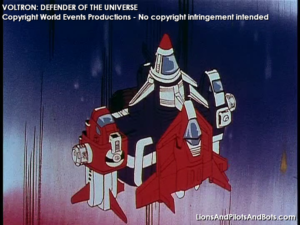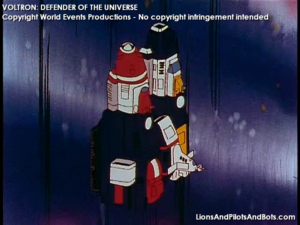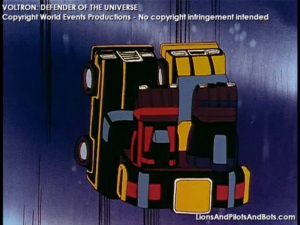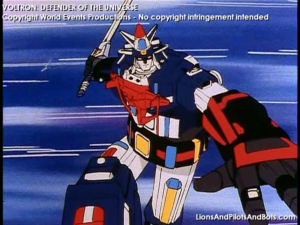
This article is a conjectural early history of Vehicle Team Voltron, as well as a conjectural “technical primer” to the power systems of Vehicle Team Voltron and its constituent Rugger vehicles, based on sometimes conflicting evidence from the Voltron: Defender of the Universe television program.
Many years before Keith, Lance, Pidge, Hunk, and Sven reached Planet Arus, Doctor Loring, the Galaxy Alliance’s eccentric but pre-eminent expert in robotics engineering, traveled in secret on an unauthorized, solo mission to Arus to learn as much as he could about Voltron, Defender of the Universe. To many, Voltron was only a legend, but Doctor Loring believed Voltron was real, and that the mighty robot now resided on Arus.
King Alfor reluctantly allowed Loring to study the Lions in secret, as long as he did not activate them, and as long as his methods were non-destructive. Loring’s presence was kept a secret from the Arusian public, the Galaxy Alliance, and the many factions of the Drule Empire.
For five short months, Loring studied the dormant Lions in their Dens. Were it not for his genius-level intellect, his decades of experience in robotics, and what little of his personal knowledge King Alfor was willing to share, Loring would have learned nothing about Voltron’s technology. By the end of the fifth month, Loring had discovered that each Voltron Lion was powered by a distinct element of nature, but there was much about this that Loring did not understand. When Loring asked King Alfor for more information about how a Lion harnessed a natural element and transformed it into usable power, Alfor, fearing that such knowledge could fall into the wrong hands, told Loring that his time on Arus had ended.
Loring returned to Earth, where he began to work in secrecy on the design of his own modular super robot – his own Voltron. A particular focus was to power the robot using an element of nature — an ancient secret of the legendary robot that, if reproduced, would provide Loring’s super robot with equal power.
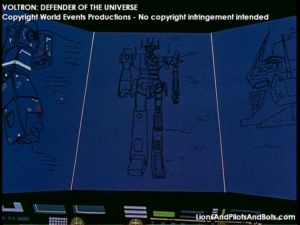
Several years after departing Arus, Loring finally completed much of the daunting but plausible design for his Voltron. Loring presented his design before the Galaxy Alliance council and the Galaxy Garrison’s top officers, requesting funding to construct his Voltron. Aware of growing threats from the Drule Empire, and a need to explore the universe to find new habitable worlds, the Alliance, by way of the Galaxy Garrison, agreed to fund the construction of Loring’s Voltron.
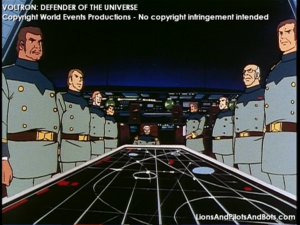
Unlike the Voltron of legends from days of long ago – a robot comprised of five robot Lions – Loring’s Voltron was to be comprised of a larger number of modules, each an independent space cruiser. A major reason for this design choice was to support the Galaxy Alliance’s effort to find new planets for the people of overcrowded worlds to colonize. Based on anticipated mission needs, the number of vehicles was set to 15 – five Air Team vehicles that were specialized for aerial operations, five Sea Team vehicles for underwater operations, and five Land Team vehicles for ground-based operations. Loring was not especially fond of designing the modules with a vehicular form factor, as it seemed too mundane to him, but with his project’s funding coming from the Galaxy Alliance, compromises were a necessity.

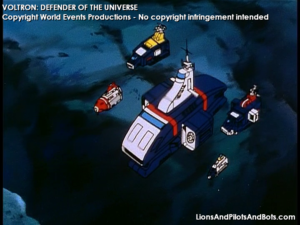
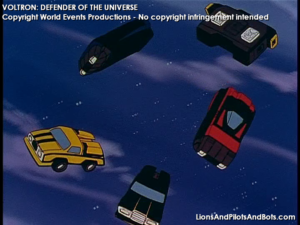
Because of the nature of its constituent modules, and the likely organization of their future pilots, “Loring’s Voltron” became known as Vehicle Team Voltron, which helped to distinguish it from the legendary “Lion Force Voltron.” Partially as a joke, and partially because of his fondness for rugby, Loring referred to Vehicle Team Voltron’s 15 constituent vehicles as Ruggers.
Loring continued to pursue powering Vehicle Team Voltron using an element of nature. Given the Alliance’s intended mission for Vehicle Team Voltron, which included the discovery and study of new, habitable planets, the super robot would need to be able to operate for long durations without reliable access to planets rich in natural resources, such as those which powered the Voltron Lions: lightning, fire, wind, water, and magma. Loring quickly realized that the only element of nature that could possibly power a super robot that spent much of its time in space was solar energy – electromagnetic radiation, or light, from stars.
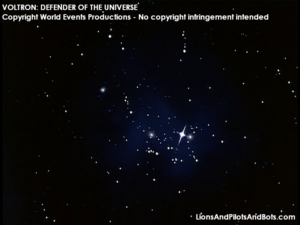
As construction began, Loring kept certain aspects of Vehicle Team Voltron’s design known only to himself – particularly details about the adaptations that he had made in order to power the super robot. Loring had grown to appreciate the wisdom of King Alfor for wanting to prevent this secret of Voltron from falling into evil hands.
The greatest challenge to using solar energy to power Vehicle Team Voltron was that the rate at which the super robot consumed power could easily exceed the rate at which it could recharge, especially when operating in interstellar space, where stars, while plentiful, were distant. Loring was on the verge of surmounting this challenge…until he died unexpectedly, and as with many aspects of Voltron’s design, this last major technical hurdle was one of the secrets that Loring took with him to the grave.
For years following Loring’s death, the Galaxy Alliance’s top engineers and scientists pored over the miniscule records that they could decrypt from the few records that Loring kept of his work. Although these great intellects could not ascertain what Loring had in mind to handle Voltron’s recharging challenge, they did devise several workarounds that, in aggregation, made Vehicle Team Voltron a true Defender of the Universe of modern legend — even if it arguably fell short of its full potential.
Numerous workarounds were devised and implemented.
- Separate Rugger fuel supply: Each Rugger was be powered by conventional spacecraft fuel, rather than draw power from Voltron’s energy reserves. A side benefit of this workaround was that, should the Ruggers lack sufficient solar energy to combine, the Ruggers could continue to operate independently.
- Power Turbos: A critical part of forming Vehicle Team Voltron was connecting the Ruggers’ diatherms and activating infracells. This sequence boosted the structural strength of the Rugger-to-Rugger connections – effectively holding Voltron together. To eliminate the need of the Ruggers to consume Voltron’s limited solar energy reserves for this purpose, each Rugger utilized a Power Turbo – a component that, when sufficiently charged, provided adequate power to connect diatherms and activate infracells. A Rugger’s Power Turbo was charged by the Rugger’s conventional fuel. When a Power Turbo was empty, a full charge could take up to four hours. For this reason, each Rugger’s Power Turbo was normally maintained at a charge level of at least 84%. A Rugger could operate normally while charging its Power Turbo.
- Embedded Solar Micropanel Matrices (ESMM): Each Rugger’s hull incorporated an Embedded Solar Micropanel Matrix (ESMM), a grid of tiny, unobtrusive solar energy collectors that fed solar energy directly into a network of batteries that powered Vehicle Team Voltron when the Ruggers were combined.
- Team Fighter configuration: To increase the Ruggers’ combat capabilities without consuming Vehicle Team Voltron’s solar energy reserves, the Ruggers of each five-module sub-team– the Air Team, Sea Team, and Land Team – could combine into a large “Team Fighter” fighter craft that drew power from its constituent Ruggers’ conventional fuel supplies.
- The five Ruggers of the Air Team formed the Strato Fighter. When combined, the Strato Fighter tapped most of its operating fuel from a primary enerty storage tank in Rugger 4 (starboard module), and an auxiliary tank in Rugger 3 (port module).
- The five Ruggers of the Sea Team formed the Aqua Fighter. When combined, the Aqua Fighter often increased its energy capacity and speed by igniting its twin Nuclear Power Thrusters (NPT), housed in Rugger 9 (port aft module) and Rugger 10 (starboard aft module). Vehicle Team Voltron could also utilize the NPTs for bursts of acceleration.
- The five Ruggers of the Land Team formed the Turbo Terrain Fighter.
- Mothership: When the Ruggers were not in use, or when Vehicle Team Voltron needed to travel over interstellar distances, the Ruggers were stored in a dedicated hangar within a mothership – the Stellar Ship Explorer.
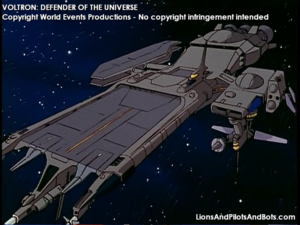
Stellar Ship Explorer - By transporting the docked Ruggers, Explorer greatly reduced the need for Voltron to travel through interstellar space, reducing the robot’s power consumption.
- Embedded Solar Micropanel Matrices (ESMM): Like the Ruggers, the hull of the Explorer incorporated an Embedded Solar Micropanel Matrix (ESMM). When the Ruggers were docked, the ESMM delivered solar energy directly to them. When the Ruggers were elsewhere, the ESMM stored solar energy in large batteries like those of the Ruggers themselves, for subsequent delivery to the Ruggers. The Explorer’s large, flat upper hull contained a high-density version of an ESMM that enabled the ship to collect enormous quantities of solar energy when the ship was landed on a planet with an Earth-like atmosphere that scattered light from the planet’s sun(s).
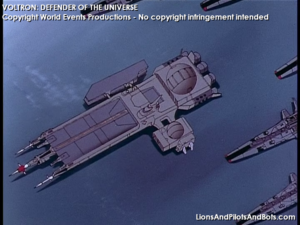
Stellar Ship Explorer in a body of water during a sunny day on a habitable planet - Thermonuclear-Powered Artificial Sunlight System (TPASS): When the Explorer was not in line-of-sight of natural solar energy, the Explorer also contained a Thermonuclear-Powered Artificial Sunlight System (TPASS) that continuously flooded the docked Ruggers in concentrated light that simulated starlight. When the hangar was devoid of people, the Voltron vehicles were usually flooded with light at ultraviolet-and-higher frequencies. When people occupied the hangar, the vehicles were bathed with lower-intensity, visible-frequency light. Because the system merely mimicked natural sunlight, its recharging capability was significantly less efficient than when the Explorer or a Rugger’s ESMM could collect natural sunlight.
Because the Ruggers were sometimes charged using the thermonuclear-based TPASS, and because a star emitted light due to internal thermonuclear reactions, it was a common to colloquially mischaracterize Vehicle Team Voltron’s energy reserves as nuclear or thermonuclear in nature, rather than solar.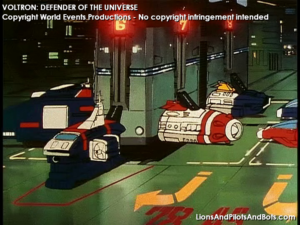
Sea Team’s five Ruggers in Rugger hangar aboard the Stellar Ship Explorer 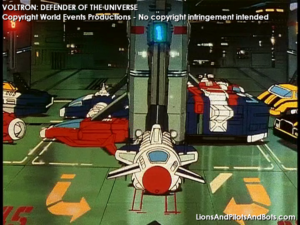
Air Team’s five Ruggers in Rugger hangar aboard the Stellar Ship Explorer 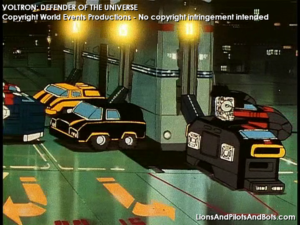
Land Team’s five Ruggers in Rugger hangar aboard the Stellar Ship Explorer
- Solar Energy System (SES): As a last-resort backup system to enable Vehicle Team Voltron to recharge more quickly while in interstellar space, the Galaxy Alliance created what it referred to generically as the Solar Energy System (SES). The SES is comprised of a sparse network of space stations and satellites that refracted and reflected light from nearby stars in focused beams to distant locations. The SES was highly inefficient – its focused beams spreading over longer interstellar distances – and the SES provided inadequate coverage in many regions of space, but it could be effective under certain conditions when the Stellar Ship Explorer or the Ruggers themselves were incapable of recharging the Ruggers’ solar energy reserves at a sufficient rate. When conditions were right, the SES transmitted deliver beams of starlight directly to the Ruggers. To be recharged successfully by the SES, the Ruggers had to be in the direct line of sight of an actively transmitting SES component.
- Incremental system upgrades: As Vehicle Team Voltron operated in the field, the greatest scientific and engineering minds of the Galaxy Alliance continued to design and implement incremental upgrades to Vehicle Team Voltron, extending the capacity of the robot’s energy reserves and increasing its ability to recharge at greater speed. Upgraded Voltron hardware and software were secretly transported to the Stellar Ship Explorer by various Galaxy Garrison support fleets. Once the upgrades were delivered, an engineering team aboard the Explorer installed and field-tested each upgrade with the help of the Ruggers’ pilots, the Voltron Vehicle Team. When initially launched, Vehicle Team Voltron, with full solar energy reserves, could operate in a Notionally Typical Combat Scenario (NTCS) for only 5.2 minutes. Through multiple system upgrades, Voltron’s NTCS capability had been increased to nearly 20 minutes, which proved to be essential during the liberation of Planet Drule. Despite these upgrades, and the increasing knowledge of the scientists and engineers who have worked on them, to this day the top minds of the Galaxy Alliance have not been able to create another successful Voltron-like super robot, even using Doctor Loring’s original plans.
Notable incidents
On rare occasions, Voltron’s power-related vulnerabilities hindered its mission capability.
- After the Explorer had landed on a planet and, with Voltron’s help, thwarted two Drule attacks, engineers aboard the Explorer took advantage of the lull in activity to drain the charge of the Ruggers’ Power Turbos for maintenance. After maintenance had completed, but before the Ruggers’ Power Turbos could be recharged fully, the Drules attacked a third time. The Ruggers could not immediately form Voltron, but they were able to combat the Drules until their Power Turbos finished recharging. Afterward the Ruggers formed Voltron and defeat the Drules and their latest Robeast.
- In the hours leading up to a massive Drule invasion of Earth, Drule Captain Durka destroyed a Galaxy Garrison space station that was a critical node in a portion of the Solar Energy System (SES) that lay between the Ruggers’ position and Earth. Because a recent battle against the Drules had already depleted much of Voltron’s energy reserves in both the Ruggers and the Explorer, it was not possible to form Voltron. The localized SES outage and Ruggers’ inability to form Voltron were not the only reasons why Voltron could not come to Earth’s defense. The inconsistent coverage provided by even a fully operational SES would not have enabled Voltron to make the entire trip from its current position to Earth under its own power, and the recent battle with the Drules had damaged the Explorer’s engines, reducing its top speed until repairs could be completed.
On other atypical occasions, Voltron’s compromised mission capability exceeded expectations.
- During combat against the Cyberbug Robeast, 0.55 minutes after Voltron was formed, a blast from the Robeast caused Voltron’s right arm to separate into Rugger 3 and Rugger 12. The Ruggers quickly recombined and enabled Voltron to defeat the Robeast.
- During combat against the Heavy Blazersect Robeast, Rugger 1 – which forms Voltron’s head and was piloted by team captain Jeff – crash landed and rendered its pilot unconscious. To face the Robeast, Sea Team leader Krik took temporary control of the Vehicle Team and ordered the team to form Voltron minus its head. Although Voltron’s combat capability was greatly diminished, the super robot remained active long enough for Rugger 1’s pilot to regain consciousness, relaunch, and form Voltron’s head. The completed robot then defeated the Robeast.
- In the middle of Voltron’s formation sequence, the Steel Spacebug Rattler Robeast blasted Rugger 7 – which forms Voltron’s right thigh and was piloted by Lisa – preventing it, Rugger 9, and Rugger 14 from forming Voltron’s right leg. The Ruggers were later able to attach, and the completed super robot defeated the Robeast.
- During combat against the Antropoda Robeast, Voltron became trapped in the Robeast’s Rocket Ropes. To escape, Voltron disassembled, its Ruggers slipped free, and the Ruggers then re-formed Voltron and continued the battle.
Conclusion
Despite its vulnerabilities, Vehicle Team Voltron has proven to be highly effective in the field. It has protected civilians and Galaxy Alliance assets and interests from the Drule Empire, it has destroyed scores of Robeasts, and it was an essential contributor to the liberation and evacuation of the people of Planet Drule. During the Akrah Incident, Vehicle Team Voltron proved to be an equal to the legendary Lion Force Voltron, as the super robots fought side-by-side against the Ultrabeast. Vehicle Team Voltron is a fusion of ancient and modern technologies, and like its Lion Force counterpart, it is a symbol of the ongoing effort to establish and maintain peace and prosperity throughout the universe.
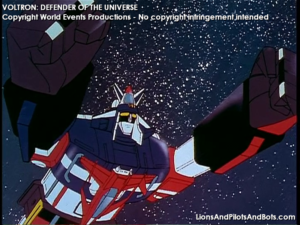
Footnotes
- Voltron: Defender of the Universe episodes’ production numbers are given in the episodes’ scripts. They are also listed in this web site’s article “Numbers, Shmumbers: Season and Episode Numbers in Voltron: Defender of the Universe.”
- Keith, Lance, Pidge, Hunk, and Sven reached Arus twice in “Space Explorers Captured” (Production #201).
- In “In Search of New Worlds” (Production #101), immediately after Voltron is formed, Jeff says, “Voltron assembled! Connect diatherms! Activate infracells!”
- Incidents were shown in “In Search of New Worlds” (Production #101) and “First Day on a New World” (Production #102).
- Robeast names are from Voltron: From Days of Long Ago: A Thirtieth Anniversary Celebration (ISBN-13: 978-1-4215-7540-7). Most Robeasts in Voltron: Defender of the Universe were not named in the episodes themselves.
- Commander Hawkins identified Vehicle Team Voltron’s power source as “stored solar energy” in “In Search of New Worlds” (Production #101).
- Commander Steele identified Vehicle Team Voltron’s power source as “stored nuclear power” in “In Search of New Worlds” (Production #101). Professor Page referred to it as “stored thermo-nuclear energy” in “A Temporary Truce” (Production #111). The Explorer‘s conjectural Thermonuclear-Powered Artificial Sunlight System (TPASS) is an attempt to reconcile the apparent contradiction between “solar energy,” “nuclear power,” and “thermo-nuclear energy.”
- The three teams’ names were established in “In Search of New Worlds” (Production #101).
- The Ruggers were first shown to be docked within and launched from the Stellar Ship Explorer in “In Search of New Worlds” (Production #101).
- In “Meanwhile Back at Galaxy Garrison” (Production #133), Doctor Loring is described as having created the “original plans for Voltron,” and for making “certain secret adaptations known only to the doctor, and these he took with him to his grave.”
- In “Meanwhile Back at Galaxy Garrison” (Production #133), Commander Steele describes a failed attempt to create another Voltron-like super robot: “Our sci-tech division has been trying to come up with a duplicate Voltron, but up to now there’s been little success. The machine that you see here was assembled by our technicians using Doctor Loring’s original plans for Voltron. Unfortunately there were certain secret adaptations known only to the doctor, and these he took with him to his grave. All of our extensive testing shows that, while this Voltron is superficially similar to the first, it is considerably inferior. It’ll never serve as a replacement for the present Voltron, or even as a backup, I’m sorry to say.”
- The term “Rugger” is not used in any Voltron: Defender of the Universe episode; however, it was used in Armored Fleet Dairugger XV, and the term “Rugger” is a less generic designation than “vehicle.”
- In “In Search of New Worlds” (Production #101), Hawkins states that “our entire team of young Space Explorers is just as determined as ever to find new and livable worlds for the people of our over-crowded galaxy.”
- The spirit of King Alfor told the Voltron Lion Force about the power source of each Lion in “Magnetic Attraction” (Production #229).
- For more information about Vehicle Team Voltron’s “Five-Minute Rule” and how closely the Voltron: Defender of the Universe television program followed, or did not follow it, see this web site’s article “The Five-Minute Rule: Vehicle Team Voltron (Voltron: Defender of the Universe).”
- In “Building a New World” (Production #103), Sparks announces that the already-launched Ruggers will “be able to form Voltron in less than an hour.” Later Sparks replies in the negative when Hawkins asks, “Does the Force have enough stored power to form Voltron?” Finally Jeff announces that, “Our power turbos are finally charged, and not a minute too soon. We’ve got to form Voltron fast!” This scenario does not occur in any other episode.
- The liberation of Planet Drule was shown in “The Drules’ World Cracks Up” (Production #150) and “The Drules Surrender” (Production #151).
- The evacuation of Planet Drule was shown in “The End of Hazar’s World” (Production #152).
- The terms “Lion Force Voltron” and “Vehicle Team Voltron” were used in Voltron: Defender of the Universe promotional materials and licensed merchandise in the 1980s.
- The Strato Fighter was first shown in “Help Not Wanted” (Production #107).
- The Aqua Fighter was first shown in “Goodbye New World” (Production #104).
- The Turbo Terrain Fighter was first shown in “Ghost Fleet from Another Planet” (Production #108).
- The “solar energy system” was mentioned and shown only in “Raid on Galaxy Garrison” (Production #130).
- Drule Captain Durka destroys a Galaxy Garrison space station, disabling solar energy refractors and commenting that the Garrison “can’t use Voltron.”
- Captain Newley tells the Galaxy Garrison’s top officers that “they’ve damaged the space station and solar energy system. Until they’re repaired, Voltron is on the disabled list.” Steele hopes “the first thing repair is Voltron’s energy source.”
- A Garrison repair technician states that “without this refractor, Voltron can’t recharge his energy.”
- Voltron’s five Land Team Ruggers are shown flying on patrol.
- Newley informs the Explorer that “as soon as [the solar energy system]’s back up to full power, you’ll have to form Voltron and stop the Drule attack force.”
- Lisa tells Jeff that the Explorer is moving toward “the area from which the Drule attack ships are coming. By the time we get there, the repair crews will have the solar energy system working, and we’ll be able to form Voltron again.”
- In “Earth’s State of Emergency,” the Armored Fleet Dairugger episode from which Voltron‘s “Raid on Galaxy Garrison” was adapted, Dairugger has no energy problems. The Rugger Guard and its fleet is unable to reach Earth in time to be of any help. The fleet is flying at half-speed because it is being repaired following a recent battle against the Galveston Empire. The fleet is also on a mission to find the Galvestons’ front line base.
- Shown in “A Curious Comet” (Production #114).
- Shown in “Defend the New World” (Production #120).
- Shown in “Just Like Earth” (Production #125).
- Shown in “A Storm of Meteors” (Production #106).
- Shown in “Fleet of Doom.” The term “Ultrabeast” is from the script.
- In “Hazar on the Carpet” (Production #123), the Strato Fighter — specifically Chip’s vehicle, Rugger 4 — is impaled by a Drule rocket. Chip says, “We took a direct hit in our energy storage tank!” Jeff replies, “Switch to the auxiliary tank!”
- In Voltron: Defender of the Universe, during ten out of the 19 times the Sea Team was ordered to form the Aqua Fighter, they were first ordered to “ignite Nuclear Power Thrusters.”
- The Sea Team was ordered to “ignite Nuclear Power Thrusters” before forming the Aqua Fighter in episodes 104 “Goodbye New World”, 118 “What’s on First”, 122 “Nerok Scores Big”, 128 “Planet of the Amazons”, 132 “A Man-Made Sun”, 134 “Hazar Bucks the Empire”, 136 “Peace! A Fish Story”, 139 “That’s the Old Ball Game”, 141 “Another Solar System”, and 143 “It’s Anybody’s World”.
- The Sea Team was not ordered to “ignite Nuclear Power Thrusters” before forming the Aqua Fighter in episodes 117 “Who’s on Second”, 119 “Great Stone Space Faces”, 123 “Hazar on the Carpet”, 126 “The Planet Trap”, 133 “Captain Newley Returns”, 144 “Frozen Assets”, 146 “It Could Be a Long War”, 147 “Color Me Invisible”, and 150 “The Drules’ World Cracks Up”.

